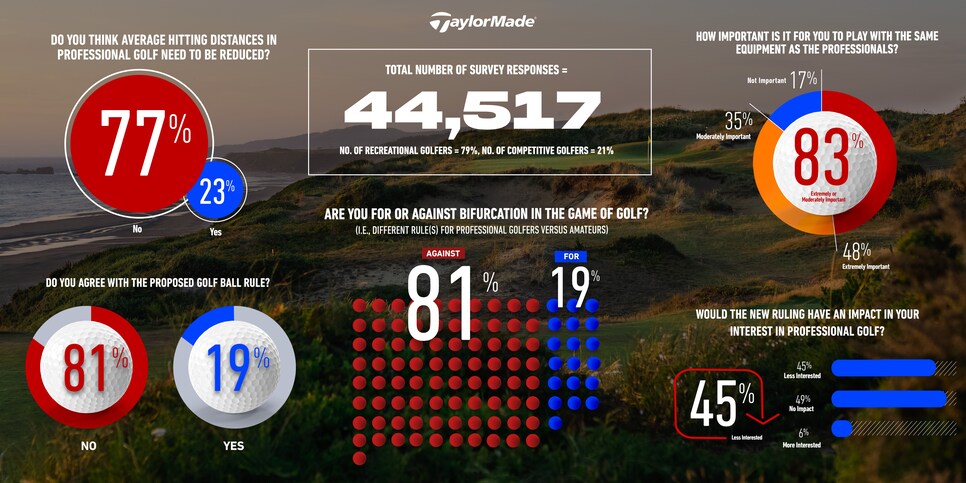Eight in 10 golfers in a worldwide poll say they are against a rolled back golf ball for elite golfers, oppose bifurcation and do not believe average hitting distances in professional golf need to be reduced. Those are the results of a recent online survey of nearly 45,000 golfers conducted by TaylorMade Golf.
The company is releasing the results of the poll it announced March 21. The intent is to share these results with the USGA and R&A, which are in the middle of a Notice and Comment period to study the ball rollback question. Specifically, the ruling bodies have proposed a Model Local Rule that would change the testing procedures for golf balls used in “elite competitions” like the U.S. Open, the Open Championship as well as the U.S. Amateur and British Amateur. The MLR’s testing parameters would raise the test speed of the swing robot from 120 miles per hour to 127, making essentially all current balls used in elite competitions non-conforming.
“The goal of our survey was to give golfers the opportunity to voice their opinion on this proposed ruling as we absorb the MLR and its potential effects on the everyday golfer,” David Abeles, TaylorMade Golf president and CEO, said in a statement. “The overwhelming amount of responses show the passion, knowledge and care for the game our audience possesses. Each response and data point is being reviewed as we will utilize this feedback in our preparation to provide a response to the USGA and R&A.”

The TaylorMade poll results, which include responses from 100 countries although 75 percent came from the U.S. and Canada, suggest a more distinct tone of anti-bifurcation and “distance is not a problem,” compared to a poll the USGA and R&A released in their Distance Insights research project in 2019. That poll revealed that 36 percent agreed with the statement that “something must be done to stop distance continuing to increase.”
The TaylorMade poll, more than half of whose respondents indicated they had been playing golf for more than 20 years, saw only 23 percent saying “Yes” to the question, “Do you think average hitting distances in professional golf need to be reduced?” The remaining 77 percent said “No,” in stark contrast to the Distance Insights poll where only 28 percent who disagreed that distance needed to be stopped (the remaining 36 percent neither agreed or disagreed).
The opposition to the MLR ball rollback in the TaylorMade poll results are slightly more aggressive but directionally the same as a recent survey from Golf Datatech, the industry’s leading research firm. That survey of serious golfers showed that 52 percent did not like the proposed rule.
Another contrast between the TaylorMade poll and the USGA/R&A poll is in the area of bifurcation. The results of the TaylorMade poll indicate that 83 percent of golfers found it either “moderately important” or “extremely important” (48 percent) that they play “with the same equipment professional golfers use.” In a slightly different yet fundamentally the same question in the USGA/R&A poll, 60 percent of those surveyed agreed that “recreational golf and professional golf are as different as two different sports.”
USGA CEO Mike Whan has been actively pursuing engagement with golf’s stakeholders on the distance question since the announcement of the proposed MLR. In a virtual town hall with USGA members last week, he framed the distance discussion in terms of “three basic premises.”
“No. 1, hitting distances have consistently increased historically,” Whan said. “That’s just a fact. And the second thing, we ought to be able to reasonably agree on is, it’s almost impossible to look me in the face and tell me that you don’t think it’s going to continue. There’s nothing in history to suggest that athleticism has somehow peaked. … And there is a real advantage to distance and where there’s an advantage and where there’s both financial and career opportunity to benefit from that advantage, we should expect them to continue to pursue that.
“The third thing I think we could all agree on is that any changes that we implement to try to make sure that we don’t sort of outpace the venues in which we play the game are going to be hard. They’re going to be disliked by the people who that change actually impacts ,and it’s going to face criticism on both sides.
“So what I would say is if you can at least get your head around those, and I know that some people can’t, and if that’s the case, I don’t really think we can have a quality dialogue.”
Here are some of the main takeaways from the TaylorMade poll:
To the best of your knowledge, do you agree with the proposed golf ball rule?
81% No
19% Yes
Are you for or against bifurcation in the game of golf (i.e., different rule(s) for professionals versus amateurs)?
81% Against
19% For
To the best of your knowledge, do you think the proposed golf ball rule is good for the game of golf?81% No
19% Yes
Do you think average hitting distances in professional golf need to be reduced?
77% No
23% Yes
How important is it for you to play with the same equipment professional golfers use?
48% Extremely important
35% Moderately important
17% Not at all important
How interested are you in professional golf?
81% Extremely interested
18% Moderately interested
1% Not interested at all
If the proposed golf ball rule were to go into effect, would it have an impact on your interest in professional golf?
45% Yes, I would be less interested
49% No, I would be just as interested
6% Yes, I would be more interested
If the proposed golf ball rule were to go into effect, would it have an impact on how much golf you play?
85% No, it wouldn’t have an impact
14% Yes, I would play less golf
1% Yes, I would play more golf



